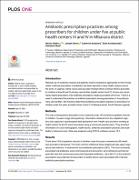| dc.contributor.author | Okello, Nelson | |
| dc.contributor.author | Oloro, Joseph | |
| dc.contributor.author | Kyakwera, Catherine | |
| dc.contributor.author | Kumbakumba, Elias | |
| dc.contributor.author | Obua, Celestino | |
| dc.date.accessioned | 2020-12-30T18:39:19Z | |
| dc.date.available | 2020-12-30T18:39:19Z | |
| dc.date.issued | 2020 | |
| dc.identifier.citation | Okello, N., Oloro, J., Kyakwera, C., Kumbakumba, E., & Obua, C. (2020). Antibiotic prescription practices among prescribers for children under five at public health centers III and IV in Mbarara district. PLOS ONE, 15(12), e0243868. https://doi.org/10.1371/journal.pone.0243868 | en_US |
| dc.identifier.uri | https://doi.org/10.1371/journal.pone.0243868 | |
| dc.identifier.uri | https://hdl.handle.net/123456789/211 | |
| dc.description.abstract | Introduction
Rational use of medicines requires that patients receive medications appropriate to their clinical
needs. Irrational prescription of antibiotics has been reported in many health systems across
the world. In Uganda, mainly nurses and assistant medical officers (Clinical officers) prescribe
for children at level III and IV primary care facilities (health center II and IV). Nurses are not primarily
trained prescribers; their antibiotic prescription maybe associated with errors. There is a
need to understand the practices of antibiotic prescription among prescribers in the public primary
care facilities. We therefore determined antibiotic prescription practices of prescribers for
children under five years at health center III and IV in Mbarara district, South Western Uganda.
Methods
This was a retrospective descriptive cross-sectional study. We reviewed outpatient records
of children <5 years of age retrospectively. Information obtained from the outpatient registers
were captured in predesigned data abstraction form. Health care providers working at
health centers III and IV were interviewed using a structured questionnaire. They provided
information on socio-demographic, health facility, antibiotic prescription practices and availability
of reference tools. Data was analyzed using STATA software version 13�0.
Results
There were 1218 outpatients records of children under five years reviewed and 35 health
care providers interviewed. The most common childhood illness diagnosed was upper respiratory
tract infection. It received the most antibiotic prescription (53%). The most commonly
prescribed oral antibiotics were cotrimoxazole and amoxicillin, and ceftriaxone and benzyl
penicillin were the commonest prescribed injectable antibiotics. Up to 68.4% of the antibiotic
prescription was irrational. No prescriber or facility factors were associated with irrational
antibiotic prescription practices. | en_US |
| dc.language.iso | en | en_US |
| dc.publisher | PLOS ONE | en_US |
| dc.subject | Antibiotic prescription | en_US |
| dc.subject | public health centers III and IV | en_US |
| dc.subject | Mbarara district | en_US |
| dc.title | Antibiotic prescription practices among prescribers for children under five at public health centers III and IV in Mbarara district | en_US |
| dc.type | Article | en_US |

